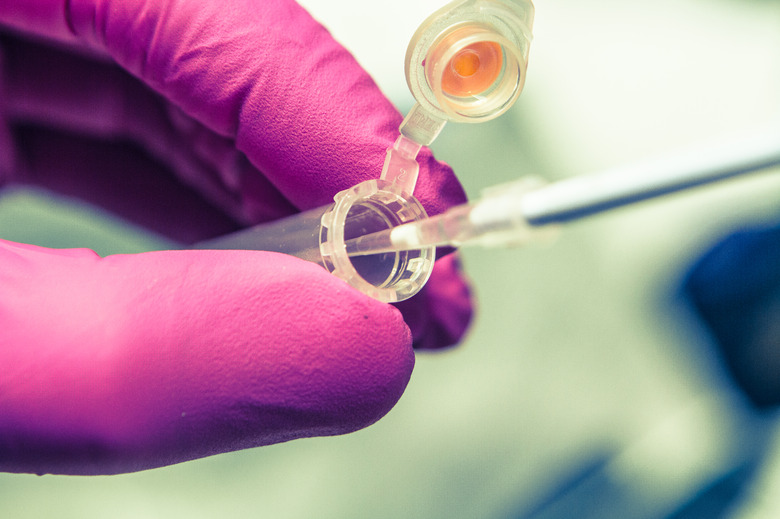How To Calculate The Charge Of An Ion
Atoms have a desire to lose or gain an electron in order to be stable. Once they've either gained or lost some electrons, they have charge associated with them since their electron and proton numbers no longer balance out. But what determines what happens to the electrons an atom has? It all has to do with the number of electrons in the valence shell of an atom.
How Many Electrons Does an Atom Have?
How Many Electrons Does an Atom Have?
In order to find how many electrons an atom has, you simply look at the atomic number. The number of electrons = the atomic number. Chlorine for example has an atomic number of 17. That means it has 17 electrons.
Whether or not chlorine will lose or gain electrons depends upon how these 17 electrons are configured around the nucleus.
Electron Configuration
Electron Configuration
The loss or gain of electrons takes place in order to make an atom more stable. As soon as this process occurs, it is no longer called an atom but an ion.
You can think about electrons being ordered into rings around the nucleus of an atom. The first ring must contain two electrons to be full. The next must contain eight. In general, once the valence shell is full, the atom is happy. It neither wants to gain or lose an electron.
What Is the Valence Shell of an Atom?
What Is the Valence Shell of an Atom?
The valence shell is the outermost shell of electrons surrounding an atom. The number of electrons in this shell are important for determining how the atom will react and what the charge of the ion could become.
Many of the elements you think about most often in biology and chemistry class need eight electrons in their valence shell in order to be stable. This is referred to as the octet rule.
Say you know that some atom has 10 electrons (can you figure out which element this is?). How many would be in the valence shell? First you take away two from 10 since the first ring has 2 elections. This leaves eight electrons. That means in the valence shell there are eight electrons and that the valence shell is full.
If the valence shell is full then nothing will happen. The atom will not ionize. As a result there will be no charge on the atom.
In this example, you have neon (did you figure out it was neon?). Neon has a full valence shell and thus does not have a charge. So what happens when the valence shell isn't full?
Becoming an Ion
Becoming an Ion
Atoms want to have a full valence shell, and they want to do it as easily as possible.
For example, take a look at chlorine again. It has 17 electrons. How many are in the valence? The first two levels will be full with 10 electrons. That means there are seven electrons left in the valence shell. This means that chlorine wants to gain an electron in order to have a complete valence shell. Once it gains the one electron what happens to the charge?
To begin with, the electrons and protons are balanced. Chlorine has 17 electrons (a charge of -17) and 17 protons (a charge of +17), so the overall charge is zero. Once the chlorine gains an electron, however, the total just becomes -1 since there are now 18 electrons and still 17 protons. As a result chlorine is a negative charged ion. It is written as: Cl-.
Negatively charged ions are called anions. What about positively charged ions? They are called cations. Take a look at this example of how a cation forms:
Magnesium is atomic number 12. That means it has 12 electrons and 12 protons. Now, how are the elections configured, and how many electrons are in the valence shell?
The first two shells are full, the first with two electrons and the second with eight. All that is left are two electrons in the valence shell. Now, the atoms could gain six electrons to make it to eight for a full shell, or it could lose two to make it to a full shell. The second way is much easier. As a result, magnesium loses two electrons.
After losing two electrons, the charge on the atom becomes +2 since there are now 10 electrons (-10) and 12 protons (+12). It is written as: Mg2+.
Ion Charge and the Periodic Table
Ion Charge and the Periodic Table
There is a trend to ion formation on the periodic table. Groups 1, 2, 13 and 14 tend to become positively charged. This means that they would rather lose some electrons to get to a complete valence shell.
Groups 15, 16 and 17 tend to have a negative charge because they would rather gain electrons to get to a complete valence shell.
Finally, in group 18, are the noble gases. These elements already have a complete valence shell. For this reason, they are unlikely to lose or gain an electron and are extremely stable.
Cite This Article
MLA
Gupta, Riti. "How To Calculate The Charge Of An Ion" sciencing.com, https://www.sciencing.com/calculate-charge-ion-5955179/. 1 February 2020.
APA
Gupta, Riti. (2020, February 1). How To Calculate The Charge Of An Ion. sciencing.com. Retrieved from https://www.sciencing.com/calculate-charge-ion-5955179/
Chicago
Gupta, Riti. How To Calculate The Charge Of An Ion last modified March 24, 2022. https://www.sciencing.com/calculate-charge-ion-5955179/
